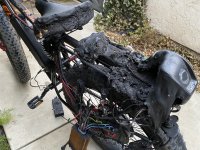I am glad you and yours and your home are safe. I have been thru a house fire (not battery- or EV-related) and lost those I cared about, so I am very glad this didn't happen to you.
There are a few possible causes, but the most likely is the battery itself, internally, since you said it was heating up during charge (which should not happen in a correctly-functioning battery, assuming typical low-current charge rates--it might be warmer than when just sitting there doing nothing, but it should never get "hot".) that also kept turning off. The specific reasons for it to be heating or turning off might be the reason for the fire, or just indirectly have lead to it.
There are other possible contributors: A battery whose BMS is not designed for a voltage higher than the battery charges to may not survive being seriesed with another battery. At the moment when the BMS tries to protect the cells inside against overcharge or overdischarge, the voltage across the FETs (charge and/or discharge) becomes higher than they can handle, and they can fail, often shorted "on", so that the BMS can no longer protect the cells inside against overcharge or overdischarge, even when it is no longer in series with the other battery.
If that happened, then the cells can overcharge, which can cause them to heat up. If they heat enough, they can internally fail and self-discharge very rapidly, which generates enough heat ot cause adjacent cells to fail, which causes a chain reaction that can lead to a fire.
If the discharge port was damaged from overvoltage, and the pack was imbalanced enough, the BMS would not have been able to turn it off (and shut the system down) in the event of cell-group-level LVC, and such a cell group could have been driven negative in voltage and been damaged by that, and failed on a subsequent recharge. (the BMS charge port would *also* have to be unable to shut off for this to happen, because otherwise it would have prevented charge in the first place, if the cell was below it's safety cutoff, unless it is so poorly designed it doesn't have one or can't respond correctly to a voltage at or less than 0V).
The controller doesn't appear to be damaged enough for this (though it may be damaged enough to not work and possibly not be testable for this failure), but another thing that could contribute is that the FETs and capacitors (and LVPS input components) in it also can only handle a certain amount of voltage. If they are not designed for the voltage of the seriesed packs, or the full charger voltage (if still connected to the pack during charge), they can fail, again often shorted (for both caps and FETs), and generate heat, which can lead to a fire if left in that condition, especially if the BMS has already failed from overvoltage so that it can't turn off it's output
Another possible contributor (which may or may not apply to your event) to battery failures is non-balancing BMSs, which many battery sellers use in their cheaper packs, especially in combination with the cheap and non-matched cells they also will typically use in them. The cells grow in imbalance, which the BMS cannot correct as it doesn't have the hardware. The pack capacity will appear to drop, and it won't fully charge, growing worse every usage cycle. It can reach a point where the cells in some groups are nearly empty and others are nearly full, and if the BMS has any form of problem that prevents it from shutting off charge or discharge in the event of cell-level HVC or LVC, cells can be dramatically overcharged or overdischarged (even to the point of going negative in voltage, which is even worse for them than other conditions), and that can lead to a fire.
Cells can also just fail internally, from manufacturing defects. This shouldn't happen (at least, very very rarely) from properly QC'd cells being used well within their specifications, but many cheap packs are probably made from cells that didn't pass QC in some way, and many (perhaps most) packs regardless of price are setup to use their cells right to the edge of their capabilities (which means that even with perfect cells to start with, as they age they'll become incapable of handling the usage they're put to, and be stressed more and more, with greater risk of failure).
We know from troubleshooting disassembly inspections in various threads that some cheap packs are made from recycled garbage cells from discarded packs from assorted sources. Some places may sort those and use only verified good ones, but QC takes time and money, so cheap packs probably don't do that, and we've seen packs that show signs that cells get used regardless of condition (even when obviously physically damaged before or during assembly).
Ebike92119 said:
Last night I woke up to loud explosions coming from my garage, it sounded like fireworks. I went into my garage and my electric bike was on fire. Sparks were flying and the smell of burning plastic was unbearable. I managed to put the fire out with a garden hose. My neighbor called the fire department. According to the fire department electric bike fires are not uncommon. If I wasn’t home to put the fire out, it certainly woulda caught the rest of my home on fire.
Why did it catch on fire? I’m hesitant to build another bike without figuring out what went wrong. Only one battery caught fire. The other battery is still functioning, which is surprising after it had been soaked with water. I had two unit power pack batteries, one battery was 54v and the other 58v. I had these batteries wired in series making 112v. The battery that caught fire kept turning off, this also happened when the battery was not wired in series. I figured the BMS was turning the battery off. Charging the battery for a few days fixed the issue. While riding around with both batteries in series I noticed the battery that caught fire was getting noticeable hot, but the other battery had a normal temperature. After leaving the bike charging for a few days that’s when the fire started. I’m unsure why the fire started.
Your thoughts and opinions are greatly appreciated.




